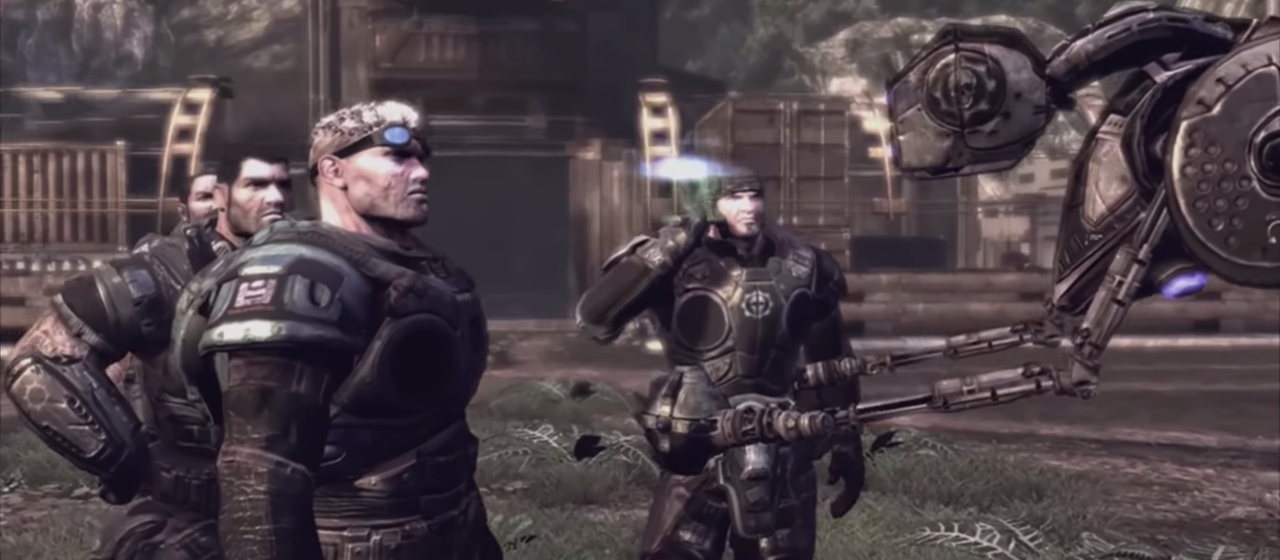
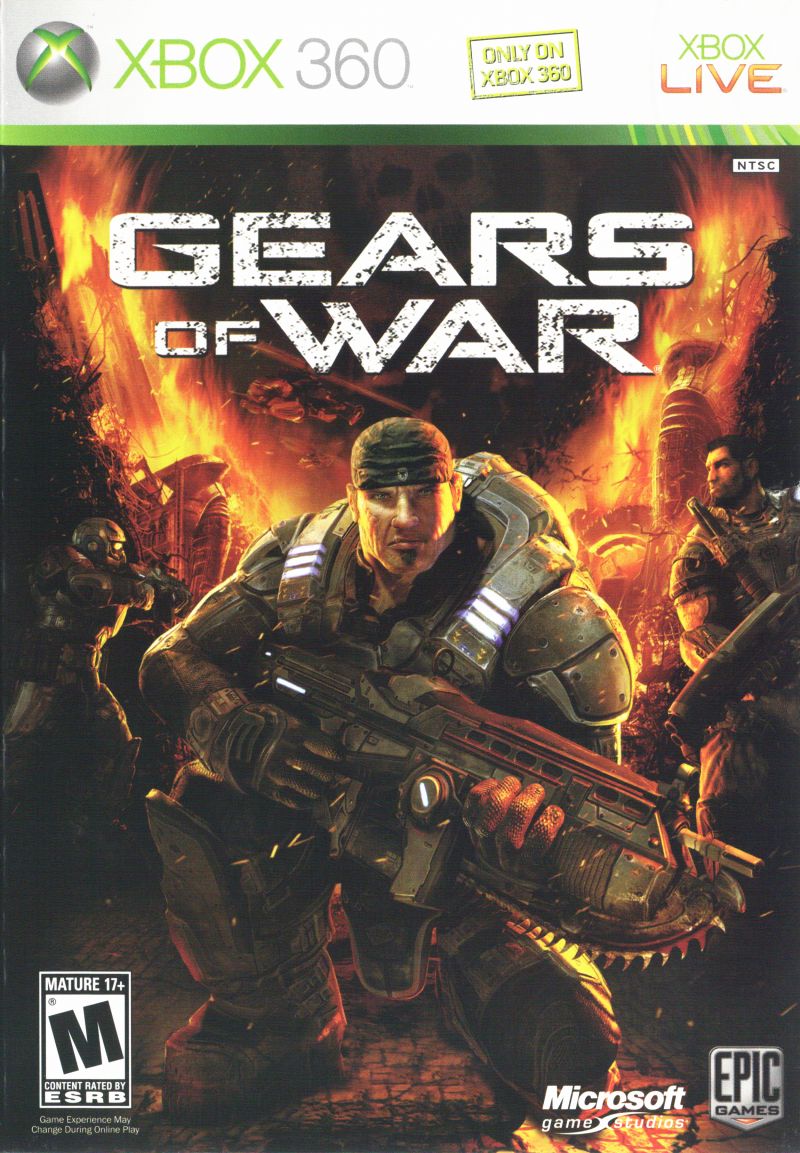
“When was the last time the wind said ‘hostiles’ to you?”
Released in late 2006, Gears of War quickly became one of the first “essential” Xbox 360 games. The brutal, claustrophobic combat system was—and is—eminently satisfying, and its memorable cast, doomsday storyline, and addictive multiplayer took the shooter market by storm. It spawned a multimedia franchise and, as an Xbox 360 exclusive, put Microsoft a step ahead of Sony in the “console wars.” Though its sequels refined the core gameplay and expanded the Gears universe, the simplicity of the first game—absent the bells and whistles that started to weigh down later installments in the series—means it still offers a great core gaming experience, carried by its stellar shooting mechanics, grisly aesthetics, and gallows humor.
Developed by Epic Games, the initial concept for Gears of War was called “Unreal Warfare” and was intended to build upon the studio’s successful Unreal Tournament series and capture the attention of gamers who were sinking untold hours into Valve’s Team Fortress (a multiplayer-only title that began its life as a Quake mod). But, if you’re familiar with the game at all, you know that Gears of War turned out entirely different from that original idea. One of the biggest changes was a shift from first-person perspective to a third-person, over-the-shoulder viewpoint. Lead designer Cliff “Cliffy B” Bleszinski, impressed by the graphical capabilities of the Unreal Engine 3—a game engine developed in-house by Epic—reasoned that seeing the grizzled Marcus Fenix issue orders and interact with his weapons, comms equipment, and environment—not to mention that his facial expressions are actually decipherable—would increase the player’s investment in the game. I’m not usually one to tout graphics, but Gears was certainly impressive for its time, prompting many to upgrade from the previous gen consoles to the Xbox 360.
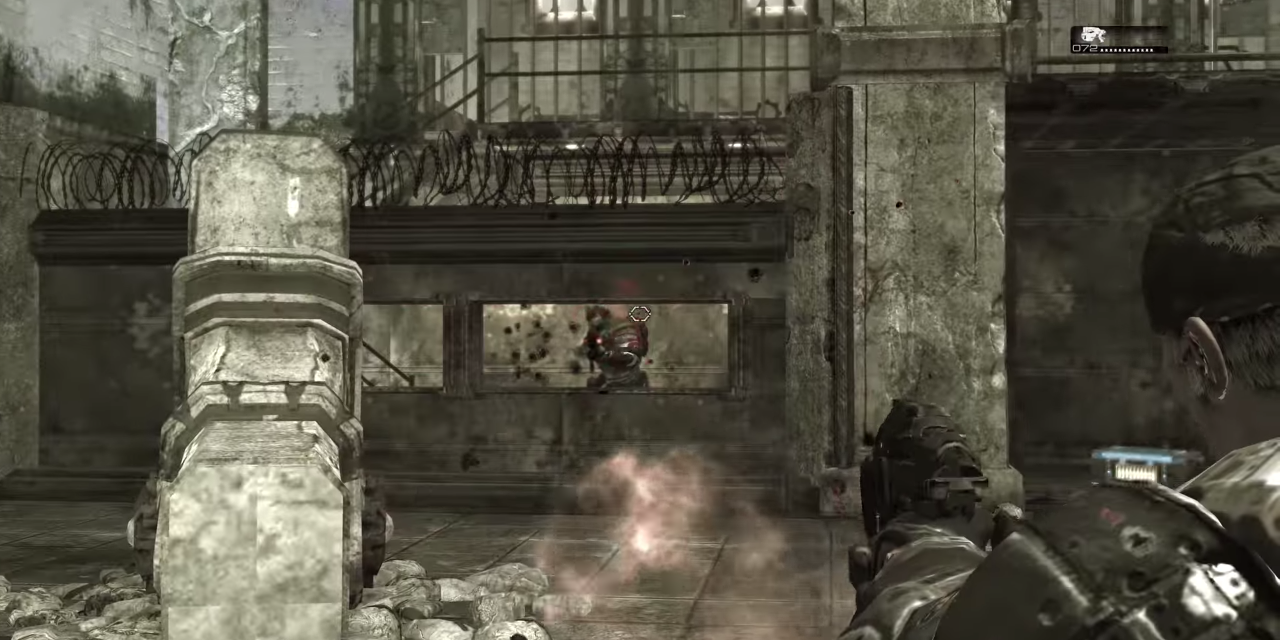
Crucially, the camera remains fixed behind the character model—meaning the player is always facing “forward.” This constraint on vision, coupled with intentionally slow rotation about the z-axis when you want to turn, forces the player to consider movement and tactics quite a bit more than in a standard run-and-gun third-person shooter. Additionally, you cannot jump, so there are no acrobatic maneuvers available to the player. As a result, the combat feels very intentional and methodical. Bleszinski was very fond of Resident Evil 4, and matched its tight, constraining camera style with the unique cover system from the less popular kill.switch to give his game its intimate, in-your-face combat style. To flesh out the core movement mechanics, the team took unlikely inspiration from the classic arcade game Bionic Commando, likening the quick movements between pieces of cover in Gears of War to the rapid grappling action of the older game.
I want to emphasize just how important movement and perspective are to the success of the combat system. To ensure players followed the intended gameplay style, the sprint function, which hugs the camera in behind the player-character and causes a “shaky-cam” effect—dubbed the “Roadie Run” after the hunched over scuttle of stage crews at rock concerts—is only 20% faster than the regular pace of movement. In other words, you don’t really want to sprint if you don’t have to because it limits your vision and isn’t gaining you much; but when you do, it’s pulse-raising in its intensity. Instead of running, the player is encouraged to hop around between bits of cover by tapping the A button when a specific icon is displayed. On the game’s highest difficulty, sans dexterous footwork and the ability to jump, becoming an expert at cover-based combat is a necessity. While in cover, nearly all enemy fire is blocked and the field of view opens up tremendously. From cover, you can blindfire, or peek up intermittently as you navigate the endless firefights that comprise the bulk of the campaign.
But I want to be careful not to overstate the game’s originality. Its appeal mostly lies in its refined combat system and stellar presentation, not so much in any single gameplay innovation. If you put a different skin on the game—which has happened many times since the game’s release (*cough* Spec Ops: The Line *cough*) and the licensing of the Unreal Engine 3—it’s still solid, but not revolutionary. And Gears is not really revolutionary either. Rather it’s a very skillfully made blockbuster that capitalizes on proven mechanics and takes few daring chances—the video game equivalent of Aliens or Jurassic Park.
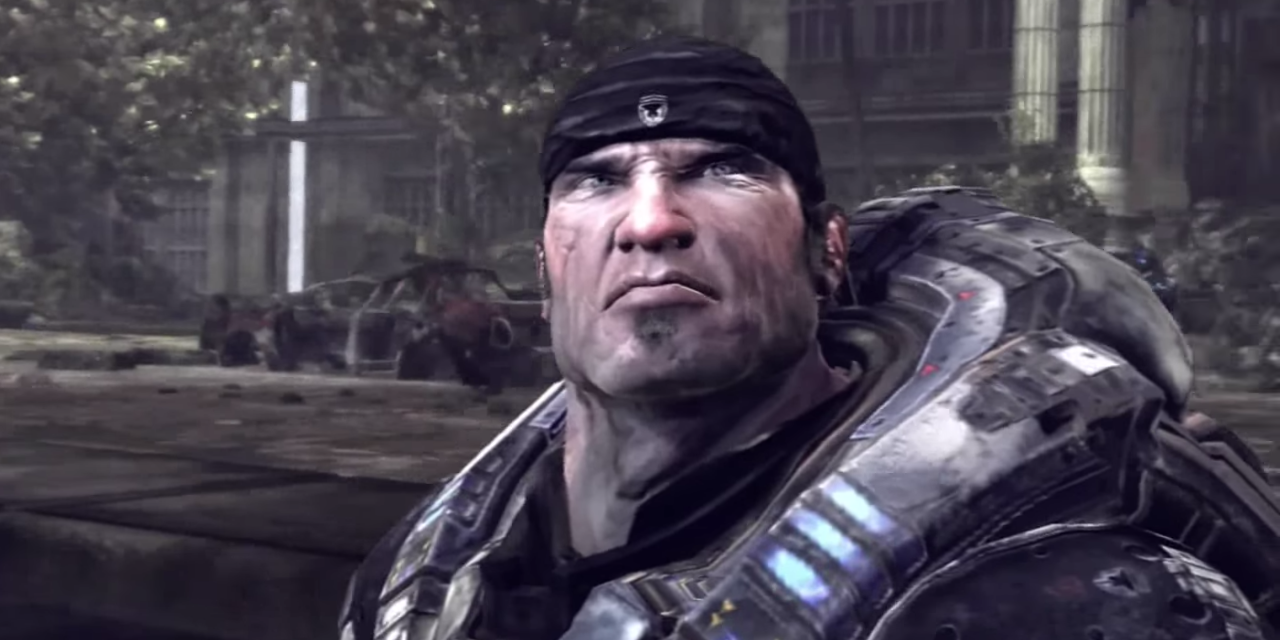
For the game’s main storyline you play as muscle-bound space marine Marcus Fenix (voiced by John DiMaggio of Futurama fame); or, if you’re player two for a co-op run on Insane difficulty—a very fun way to play the game—you play as similarly steroided macho man Dominic Santiago. I’ve always been impressed with the backstory that Gears of War is set against as well as its cinematic presentation. It’s not groundbreaking, but it serves its purpose as an adequate backdrop, and is definitely better than you have any right to expect from a game that is essentially centered around meathead soldiers obliterating eight foot tall mutants. It features a low-brow macho bro militarism but makes up for it by nailing a tone that tightropes between endearing banter and the personal trauma of suffering through a life-altering cataclysm. After the events of the 79-year-long Pendulum War, brought on by economic upheaval caused by a scientific breakthrough in the energy sector, a race of humanoid Locusts emerge from their subterranean lair in the core of the planet of Sera. A small political faction, known as the COG—The Coalition of Ordered Governments, evolved from a formerly obscure political philosophy—instituted martial law by deploying their supersoldiers, known as Gears. Taking drastic measures and making great sacrifices of life and resources, humanity retreated to the Jacinto Plateau, a secure location impenetrable by the tunneling Locusts.
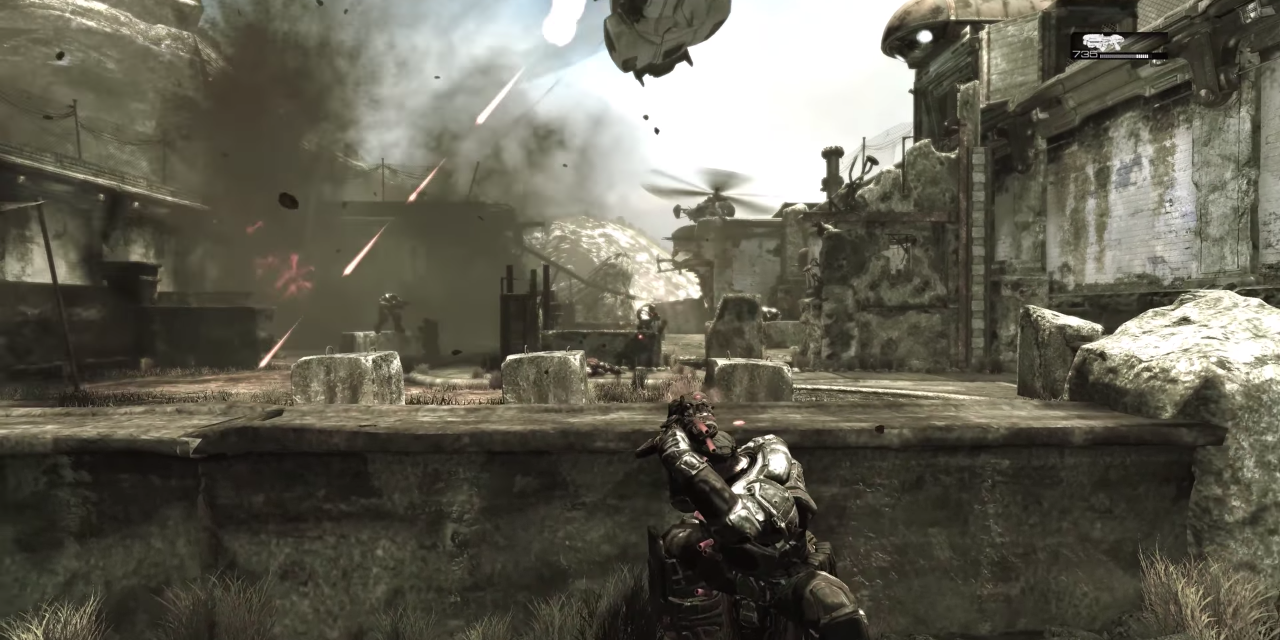
There’s decent dramatic tension as well—again, it’s not necessarily something that would stand up to scrutiny if it were detached from the game, but it is very good for what it is. Marcus Fenix, imprisoned for abandoning his post in a failed attempt to save his father, is reinstated to his position after a particularly bloody conflict between the COG and the Locusts. The main goal of the game is to map the Locusts’ underground tunnels and deploy a bomb that will wipe out the heart of their network. It folds back into the story of Marcus’s father and features some fairly decent, if light, character development that was solid enough that you actually remember some of the characters’ names and backstories (which is unusual for me and a video game). One of the keys to the game’s memorability is the supporting cast and the brotherly banter. Joining Marcus and Dom are August Cole, a gigantic retired “Thrashball” player, and the wise-cracking polymath Damon Baird. All four main characters are fairly well developed considering the short length of the campaign.
But, looking at Gears from a zoomed out perspective, thinking about what draws players to it and what made it stand out so starkly upon release, it’s clear that the story is only a thin sheen overtop of the solid mechanics. The core of the game is its intense combat and excellent pacing. While the cover system provides means for positioning, the enemy AI are relentlessly confrontational. The weapon aiming is often imprecise, and you find that close quarters, high stakes skirmishes are a more effective means to your desired end. To facilitate this combat style, featured prominently throughout the game is the Lancer, an assault rifle with a chainsaw bayonet. It’s fun to rip through a Locust, splattering blood onto the screen, but also risky, as it exposes the player for a few seconds and is prone to disruption. Equally satisfying is “curb stomping,” or squashing the head of a downed Locust beneath a military-issue boot.
Many of the gameplay elements that Gears of War put together in such a slick package have become mainstays in the genre, but my favorite is active reload. In a regular shooter, you press a button to reload, wait for that action to occur, then start shooting again. In Gears, a perfectly timed second press of the reload button cuts the reload time significantly and gives the ensuing magazine a damage boost; fail in the timing, though, and your gun jams. High risk, high reward, so of course, I tried to do it the vast majority of the time.
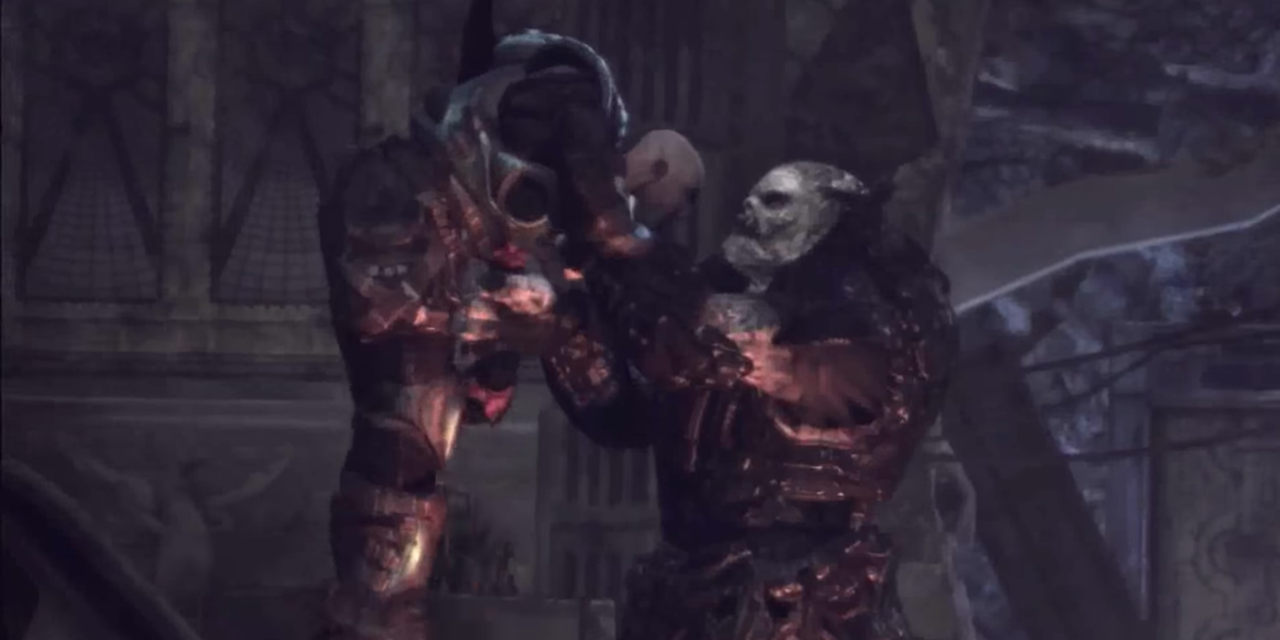
As you progress through the game’s five chapters, it follows its genre’s conventions, but does so expertly. New weapons—including the super-cool Hammer of Dawn—are introduced, as are different enemy types and evolving level design. Firefights get larger, bosses get harder, and the environments are mixed up enough to feel fresh. (To me, the only faults on this front are the vehicle sections, which were more tedious than engaging, and the sections where you are forced to split up in co-op. Basically, it fumbles the ball when it strays from its extremely tight core gameplay model.) Like a good film, it’s not just the story that’s good, but the delivery. As soon as you think you’ve got a handle on things, the game drops something new in your lap; something that’s likely to result in a few death screens.
I don’t have much experience with the wildly popular online modes—not that it didn’t seem interesting to me, but because online multiplayer is a never-ending time sink that I largely try to avoid due to my own addictive tendencies. Another huge time sink since their introduction on the 360 is Achievement Points, and Gears of War has one of the most daunting—titled “Seriously…” it requires the player to rack up 10,000 kills in online multiplayer, a feat that more than a few gamers are still gunning for today (14 years after the game’s release).
For many in my generation, Gears of War is one of those touchstone experiences in gaming. It was the first taste of startling, unfiltered gore and f-bombs. It remains prominent due to the ensuing series’ longevity and its impact on the third-person shooter genre, but the initial game still holds up remarkably well.
Sources:
Thorsen, Tor. “GDC 07: Cliffy B disassembles Gears, mentions sequel”. GameSpot. 10 March 2007. (Archived).